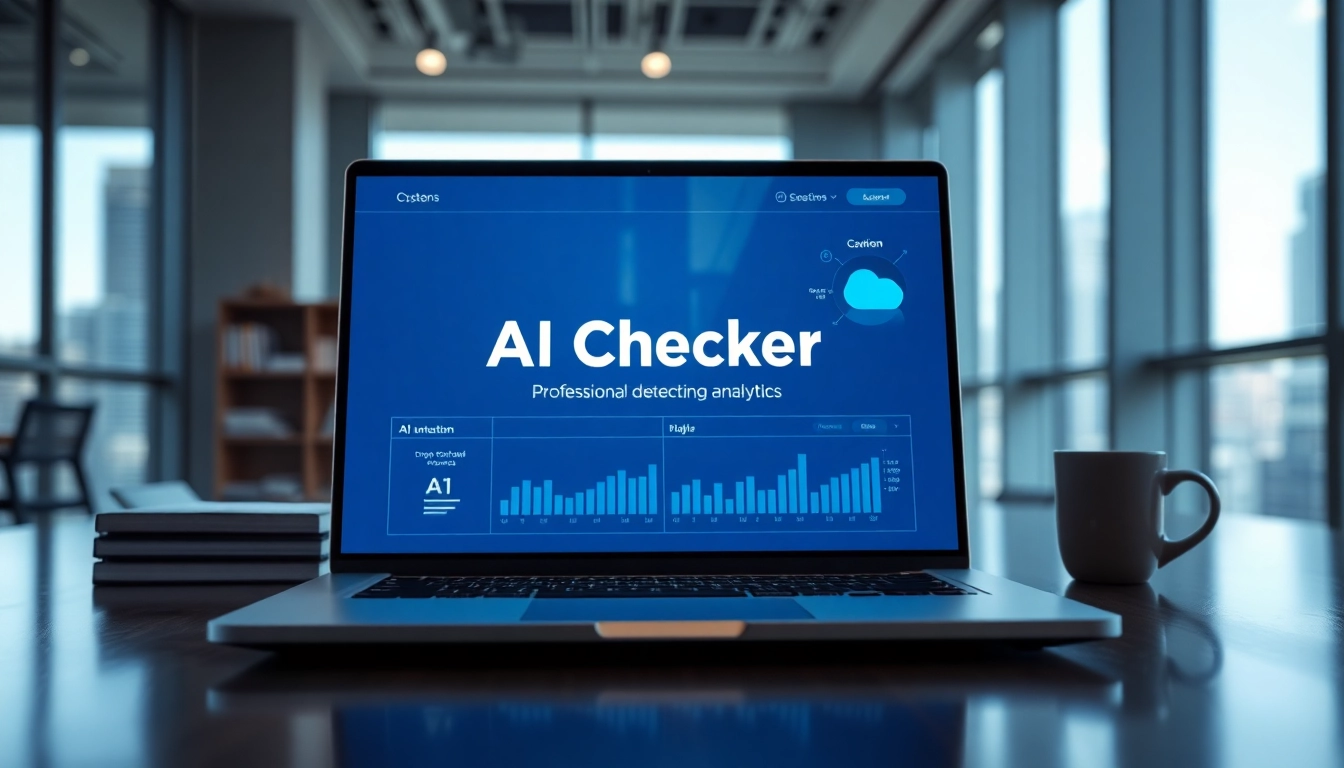
Understanding AI Checkers
What is an AI Checker?
AI checkers are sophisticated tools designed to identify whether a piece of content has been generated or influenced by artificial intelligence. As AI technologies become increasingly prevalent in content creation, distinguishing between human-generated writing and computer-generated text has emerged as a critical challenge. An AI checker leverages algorithms and machine learning models to analyze written content and determine its origin. These tools can be particularly useful for educators, publishers, and organizations that wish to verify the authenticity of the texts they handle.
How AI Checkers Work
AI checkers operate using a combination of linguistic analysis and statistical models. When a text is submitted for evaluation, the checker analyzes various features such as sentence structure, word choice, and coherence. Advanced tools may employ deep learning algorithms, training on a dataset of both human-written and AI-generated content to refine their accuracy. The process may involve:
- Text Segmentation: Breaking down the text into manageable pieces for analysis.
- Feature Extraction: Identifying key characteristics of the text, such as unpredictability and repetitiveness, which are common in AI-generated content.
- Classification Models: Using algorithms to classify the text as human or AI-generated based on the extracted features.
Importance of AI Detection
The importance of AI detection tools goes hand in hand with the rise of AI technologies in content generation. Their relevance stretches across various domains:
- Academic Integrity: Educators use AI checkers to ensure that submitted assignments are the work of students, promoting authentic learning.
- Content Authenticity: Publishers leverage these tools to maintain credibility, ensuring that articles, reports, and papers meet their standards of originality.
- SEO Benefits: Search engines favor original content, thus employing AI checkers can help maintain a high-quality standard that enhances visibility online.
Types of AI Checkers Available
Free vs. Paid AI Checkers
AI checkers can be broadly categorized into free and paid options, each offering distinct advantages and limitations. Free AI checkers typically require no upfront investment, making them accessible for casual use. However, they may come with restrictions such as character limits or basic feature sets. Paid AI checkers, on the other hand, often provide more comprehensive features, including:
- Higher Character Limits: Enabling users to check longer texts more efficiently.
- Advanced Algorithms: Offering improved accuracy through sophisticated machine learning models.
- Additional Tools: Some services include plagiarism checking or contextual analysis to enhance performance.
Key Features to Look For
When selecting an AI checker, it is essential to consider several key features that influence the effectiveness of the tool:
- Accuracy: The tool should provide reliable detection rates, ideally backed by user testimonials or independent testing.
- User-Friendliness: A straightforward interface with easy navigation enhances user experience.
- Data Privacy: Understanding how your text data is handled is crucial, especially for sensitive content.
- Support & Documentation: Comprehensive support and tutorials can facilitate effective utilization of the tool.
Popular AI Checker Tools Comparison
Several AI checkers are prominent in the market today, each offering unique features. Here’s a brief comparison of a few notable tools:
| Tool | Type | Key Features |
|---|---|---|
| ZeroGPT | Paid | Multi-stage analysis, high accuracy. |
| QuillBot | Free | User-friendly, supports multiple AI models. |
| Grammarly AI Checker | Free/Paid | Combined grammar and AI Detection tools. |
| GPTZero | Free/Paid | Supported by media coverage, allows up to 50,000 characters. |
How to Use an AI Checker Efficiently
Step-by-Step Guide to Using AI Checkers
Utilizing an AI checker effectively involves a systematic approach. Follow these steps to maximize your results:
- Select Your Tool: Choose an AI checker that meets your requirements regarding features and budget.
- Prepare Your Text: Ensure the content is formatted properly to enhance the checker’s analysis.
- Run the Check: Submit the text for analysis and wait for the results. Most tools provide immediate feedback, while others may require a short processing time.
- Analyze the Results: Review the findings carefully, paying attention to any flagged sections.
- Modify If Needed: If AI-generated content is detected, consider revising sections to improve originality before resubmitting.
Common Mistakes to Avoid
Even when using advanced AI checkers, errors can occur. Here are common pitfalls to watch out for:
- Ignoring Context: Misinterpretation can happen when users do not consider the context of a piece, leading to unnecessary revisions.
- Over-Reliance: Users should not depend solely on AI checkers; human judgment is crucial in assessing writing quality.
- Failing to Use Updates: Always utilize the latest version of AI checkers; updates often include improved algorithms.
Advanced Settings to Optimize Detection
Most AI checkers offer advanced settings tailored for specific uses. Users should familiarize themselves with these options:
- Customization: Some tools allow users to adjust sensitivity settings to better match preferred detection levels.
- Language Selection: Opt for the right language when analyzing text to enhance accuracy.
- Character Limits: Awareness of character limits can avoid submission failures; consider this when using free tools.
Case Studies and User Experiences
Successful Implementations of AI Checkers
AI checkers have found significant applications across various industries. For instance:
- Education Sector: A notable university integrated AI checkers into their thesis evaluation process, resulting in a 30% decrease in academic dishonesty incidents.
- Publishing Industry: A publishing house adopted AI detection tools to vet submissions, enhancing their reputation for quality content.
- Content Agencies: Agencies report increased client satisfaction as a result of employing AI checkers, ensuring original content delivery.
Testimonials from Users
Users across diverse sectors have shared their positive experiences with AI checkers:
“Using an AI checker has been a game-changer for my academic work. It not only enhances my learning but also helps me maintain integrity in my submissions.” – Sarah, Graduate Student
“As a content writer, I rely on AI checkers to ensure my articles remain unique. The accuracy of these tools is impressive.” – James, Freelance Writer
Real-World Issues Addressed by AI Detection
AI checkers have resolved significant issues in various settings. For example:
- Plagiarism Detection: Universities facing rising plagiarism rates utilized AI checkers to monitor submissions effectively.
- Content Authenticity: Brands have implemented AI detection to avoid false claims of authorship, maintaining market integrity.
Future Trends in AI Detection Technology
Emerging Technologies and Their Impact
As the landscape of AI continues to evolve, so too do the technologies behind AI detection. Emerging trends include:
- Integration with Other Tools: AI checkers are increasingly being combined with writing assistants to provide real-time feedback.
- Machine Learning Enhancements: Advanced algorithms are anticipated to improve accuracy rates further by learning from new data inputs over time.
How AI Checkers Will Evolve
The next generation of AI checkers is likely to become more sophisticated, with features such as:
- Multi-Language Support: As the global marketplace expands, AI checkers will need to support various languages more effectively.
- Contextual Analysis: Development in natural language processing (NLP) will facilitate deeper context understanding, improving detection rates.
Staying Ahead of the Curve with AI Solutions
For organizations and individuals aiming to remain competitive in content creation, embracing AI checkers is crucial. Regularly updating tools and staying informed on technological advances can enhance the quality of output, ensuring relevance in an ever-evolving digital landscape.







